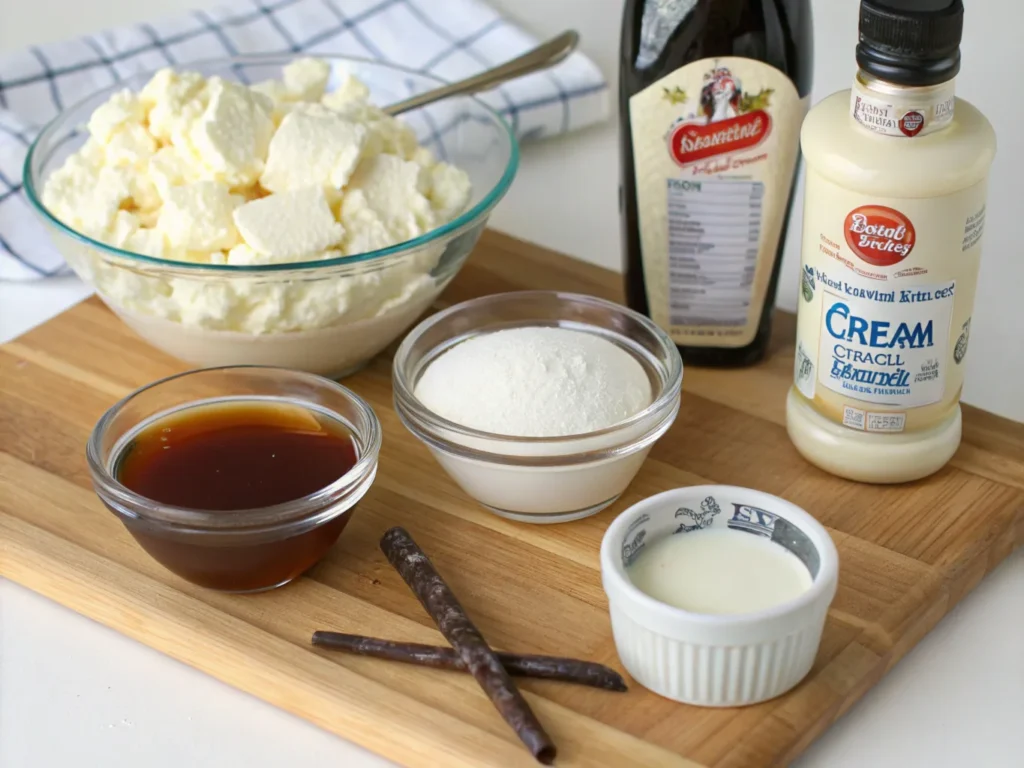Introduction
Cream cheese filling is a versatile and delicious addition to a wide variety of baked goods. Whether used in cakes, pastries, or savory dishes, it brings a rich, smooth texture and a tangy flavor that complements a wide range of recipes. This creamy mixture has become a staple in many kitchens, offering a delightful contrast to both sweet and savory creations. In this guide, we’ll explore the ingredients, techniques, and popular uses for cream cheese frosting, giving you everything you need to perfect this essential component of baking.
Table of contents
Key Ingredients for a Perfect Filling
To create the perfect cream cheese frosting, you will need a few basic ingredients. Each of these components contributes to the flavor, texture, and consistency of the final result. Here’s a breakdown of the key ingredients:
- Cream Cheese: This is the star of the mixture, providing a rich, creamy base with a subtle tang. Full-fat cream cheese is preferred for the smoothest and most flavorful result.
- Butter: Butter adds richness and enhances the creamy texture of the filling.
- Powdered Sugar: Powdered sugar is commonly used to sweeten the mixture without making it grainy.
- Vanilla Extract: Adds a natural sweetness and a hint of depth to the flavor profile.
- Heavy Cream (optional): Heavy cream can be added to achieve a lighter, fluffier texture if desired.
For a savory twist, explore alternatives like using cream cheese in flatbread recipes, such as the Cottage Cheese Flatbread or learn how to perfect its texture with Why is My Cottage Cheese Flatbread Soggy?.

Simple Steps to Make the Perfect Frosting
Making a cream cheese frosting is surprisingly easy and requires just a few steps. With a few simple techniques, you can prepare a mixture that will elevate any dessert. Here’s how you can do it:
- Soften the Cream Cheese: Begin by letting the cream cheese come to room temperature. This helps prevent lumps and ensures a smoother mixture.
- Cream the Butter and Cream Cheese: In a mixing bowl, combine the softened cream cheese and butter. Using a hand mixer or stand mixer, beat the two together until smooth and creamy.
- Add Sugar and Vanilla: Gradually add powdered sugar and vanilla extract, continuing to mix until the result becomes smooth and fluffy.
- Adjust the Consistency: If you’d like a lighter mixture, add a small amount of heavy cream to achieve your desired consistency.
This basic frosting can also be enhanced with creative pairings like pastries. Try it in croissants or Danishes, as shown in the Authentic Gipfeli Recipe.
Tips for Achieving a Smooth Texture
Achieving the perfect cream cheese frosting requires a few key techniques. Keep these tips in mind to ensure your mixture is smooth, flavorful, and easy to work with:
- Use Room Temperature Ingredients: This ensures that the cream cheese and butter blend together smoothly, without lumps.
- Don’t Overmix: Overmixing can cause the mixture to become too runny. Mix only until the ingredients are just combined.
- Taste and Adjust: Taste the mixture and adjust the sweetness or flavor by adding more powdered sugar or vanilla, if needed.
- Consider Adding Flavors: Adding flavorings such as lemon zest or cocoa powder can elevate the cream cheese frosting, especially for specific recipes.
These simple tips can make a significant difference in the outcome of your cream cheese frosting.
Versatile Uses for Cream Cheese Filling
There are countless ways to use cream cheese filling in your baking. Here are some popular dishes that feature this creamy and delicious mixture:
- Cakes: Whether layered or swirled, cream cheese frosting adds moisture and tanginess to cake recipes, such as carrot cake or red velvet cake.
- Cupcakes: A cream cheese frosting makes a perfect topping for cupcakes, offering a sweet, creamy contrast to the cake itself.
- Cheesecakes: Cream cheese filling is the base for many cheesecake recipes, providing that signature smooth and tangy texture.
- Pastries: Incorporate cream cheese in baked delights like Danishes or turnovers. Enhance these treats with the Recipe: Apple Pecan Danish Pastry Tart.
As you can see, the versatility of cream cheese frosting makes it a staple in a wide range of delicious desserts.
Cream Cheese Frosting for Cakes and Cupcakes
When it comes to cakes and cupcakes, cream cheese filling is a must-try. It adds a luxurious texture and a tangy flavor that enhances the sweetness of the cake. Here are a few popular ways to incorporate cream cheese frosting into cakes and cupcakes:
- Layer Cakes: Spread the mixture between layers of cake for a smooth and creamy texture that pairs perfectly with spiced cakes like carrot or pumpkin.
- Cupcakes: Use cream cheese frosting as a topping or as a hidden surprise inside the cupcake for a delightful contrast.
- Frosting: For a rich, creamy topping, whip the cream cheese mixture until light and fluffy and spread it over your favorite cake or cupcake.
The beauty of cream cheese filling lies in its ability to complement a wide variety of cake flavors, from chocolate to fruit-based options.
Cream Cheese Filling for Pies and Pastries
This recipe is also a great choice for pies and pastries. Its creamy consistency and tangy flavor pair wonderfully with buttery crusts and fruity fillings. Consider these options for using cream cheese frosting in your pies and pastries:
- Fruit Pies: Use cream cheese filling as a base for fruit pies, such as strawberry or blueberry, for a rich and tangy contrast to the sweetness of the fruit.
- Pastries: Incorporate cream cheese frosting into pastries like Danishes or puff pastries for a delightful, creamy surprise in each bite.
- Tarts: In tarts, cream cheese filling serves as a smooth, flavorful filling that pairs well with fresh fruit toppings.
The creamy texture of cream cheese frosting makes it a perfect addition to many pie and pastry recipes, elevating the flavor and consistency.

Sweet vs. Savory Cream Cheese Filling
While cream cheese frosting is often associated with sweet dishes, it can also be used in savory recipes. The distinct tang of the cream cheese provides balance and depth of flavor, regardless of whether you’re making a sweet or savory dish. Here’s a comparison:
- Sweet Cream Cheese Frosting: Commonly used in desserts like cakes, cupcakes, and pastries, it pairs well with fruits, chocolates, and spices.
- Savory Cream Cheese Filling: Used in savory baked goods like stuffed breads, savory pastries, and even as a dip base. Flavoring it with herbs or spices can make it an ideal choice for savory dishes.
Both versions of cream cheese filling have their place in the kitchen and can be adapted to suit your needs. To try savory applications, explore related recipes like the Cottage Cheese Flatbread.
The Nutritional Value of Cream Cheese Filling
When making cream cheese frosting, it’s important to consider the nutritional content, especially if you are mindful of dietary choices. Here’s a breakdown of the basic nutritional aspects:
- Calories: Cream cheese filling is typically high in calories due to its fat content, making it a rich ingredient in desserts.
- Fat: Cream cheese and butter contribute significant fat, particularly saturated fat.
- Sugar: Powdered sugar is used to sweeten the filling, contributing carbohydrates and sugars.
- Protein: Cream cheese provides a small amount of protein, but it is not a significant source.
While delicious, it’s important to enjoy cream cheese frosting in moderation if you’re watching your calorie or fat intake.
Cream Cheese Filling and Dietary Restrictions
For those with dietary restrictions, there are ways to adapt cream cheese frosting to fit specific needs:
- Gluten-Free: The basic recipe for cream cheese filling is gluten-free as it does not contain flour. However, always check other ingredients to ensure they are gluten-free.
- Dairy-Free: To make cream cheese frosting dairy-free, substitute the cream cheese and butter with plant-based alternatives like vegan cream cheese and margarine.
- Low-Sugar: Use a sugar substitute or reduce the amount of powdered sugar for a lower-sugar version of cream cheese filling.
With these modifications, cream cheese frosting can be enjoyed by almost anyone, regardless of dietary restrictions.
Flavor Variations for Cream Cheese Filling
While the classic cream cheese filling is already delicious, you can easily adjust its flavor to match your recipe or taste preferences. Here are some variations to try:
- Lemon: Add lemon juice and zest for a zesty twist that pairs well with fruit-based cakes or cupcakes.
- Chocolate: Mix in cocoa powder or melted chocolate for a rich and indulgent filling.
- Cinnamon: Add cinnamon for a warm, spiced flavor that pairs well with fall desserts.
- Maple: Maple syrup can add a touch of sweetness and a unique flavor to your filling.
These variations allow you to tailor the cream cheese frosting to suit different types of dishes.

Storing and Freezing Cream Cheese Filling
Storing and freezing cream cheese frosting is easy, but it requires some attention to maintain its texture and flavor. Here’s how you can store it properly:
- Refrigeration: Store your cream cheese filling in an airtight container in the refrigerator for up to 1 week.
- Freezing: If you want to make it ahead of time, freeze cream cheese frosting in a freezer-safe container for up to 3 months. Allow it to thaw in the refrigerator before using.
By following these storage tips, you can ensure that your cream cheese mixture stays fresh and ready to use.
Common Mistakes to Avoid When Making Cream Cheese Filling
There are a few common mistakes people make when preparing cream cheese filling. To avoid them, keep the following tips in mind:
- Using Cold Cream Cheese: Cold cream cheese can cause lumps in your mixture. Always use room temperature cream cheese for the best texture.
- Overmixing: Overmixing the filling can cause it to become too runny. Mix only until smooth and combined.
- Not Tasting: Always taste your cream cheese frosting and adjust the sweetness or flavorings as necessary.
Avoiding these common mistakes will help you achieve the perfect cream cheese filling every time.
Pairing Cream Cheese Filling with Other Ingredients
Cream cheese frosting can be paired with a variety of ingredients to enhance its flavor and texture. Here are some great options for pairing:
- Fruits: Cream cheese filling pairs beautifully with fresh berries, citrus, or tropical fruits.
- Spices: Adding spices like cinnamon, nutmeg, or cardamom can enhance the flavor of your mixture.
- Chocolate: For a decadent dessert, pair your cream cheese filling with chocolate cakes or cookies.
Experimenting with different pairings allows you to create endless variations of cream cheese frosting.
The History of Cream Cheese Filling in Baking
Cream cheese filling has been a staple in baking for decades. It gained popularity in the United States in the early 20th century, with the invention of cream cheese by William Lawrence in 1872. Over the years, it became a popular ingredient in cheesecakes, frostings, and pastries. Today, cream cheese filling continues to be a beloved addition to many baked goods, admired for its creamy texture and tangy flavor.
FAQs
How do you thicken cream fillings?
To thicken cream fillings, you can use a few simple techniques:
Add powdered sugar: This will not only thicken the filling but also sweeten it.
Use cornstarch: A small amount of cornstarch can be mixed with cold cream or liquid before being added to the filling to help thicken it.
Whip the filling longer: Sometimes, whipping the cream or the filling for longer can incorporate more air, which helps it thicken naturally.
These methods will help create a thicker texture for your cream cheese mixture without compromising its taste.
Why won’t my cream cheese thicken?
If your cream cheese filling won’t thicken, it may be due to cold ingredients, overmixing, or too much liquid. Ensure the cream cheese and butter are at room temperature, mix just until smooth, and avoid excess liquid for the perfect consistency.
What’s the difference between buttercream and cream cheese filling?
Both buttercream and cream cheese filling are popular frosting options, but they have key differences:
Flavor: cream cheese mixture has a tangy flavor from the cream cheese, while buttercream is much sweeter and richer.
Texture: Buttercream is usually light and fluffy, while cream cheese mixture tends to be denser and creamier due to the cream cheese.
Use: Buttercream is often used for sweet cakes and cupcakes, while cream cheese filling is great for both sweet and savory dishes, providing a more complex flavor.
Each has its own unique texture and flavor profile, making them suited to different kinds of desserts.
How do you make cream cheese filling thicker?
To make your cream cheese mixture thicker, try the following:
Add powdered sugar: Gradually incorporate powdered sugar into the filling for added sweetness and thickness.
Chill the filling: Place the filling in the refrigerator for 30 minutes to firm up before using.
Use heavy cream or cornstarch: These ingredients can help create a thicker consistency if your filling is too runny.
These methods will help thicken the filling while keeping its creamy texture intact.
Conclusion
Cream cheese filling is an incredibly versatile component that can elevate both sweet and savory creations. Whether you’re layering it in cakes, piping it into pastries, or spreading it on flatbreads, its creamy texture and tangy flavor offer endless possibilities. For more ideas, explore recipes like Vintage Cake Recipes or Baked Cottage Cheese Recipe to expand your culinary repertoire.

